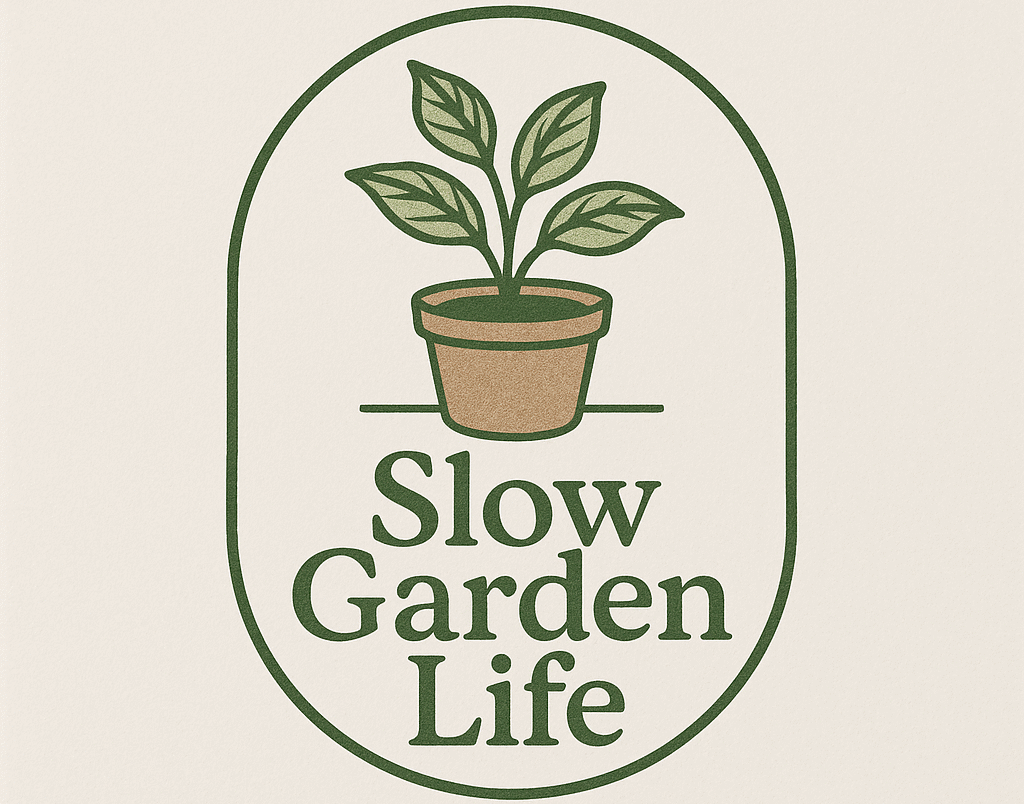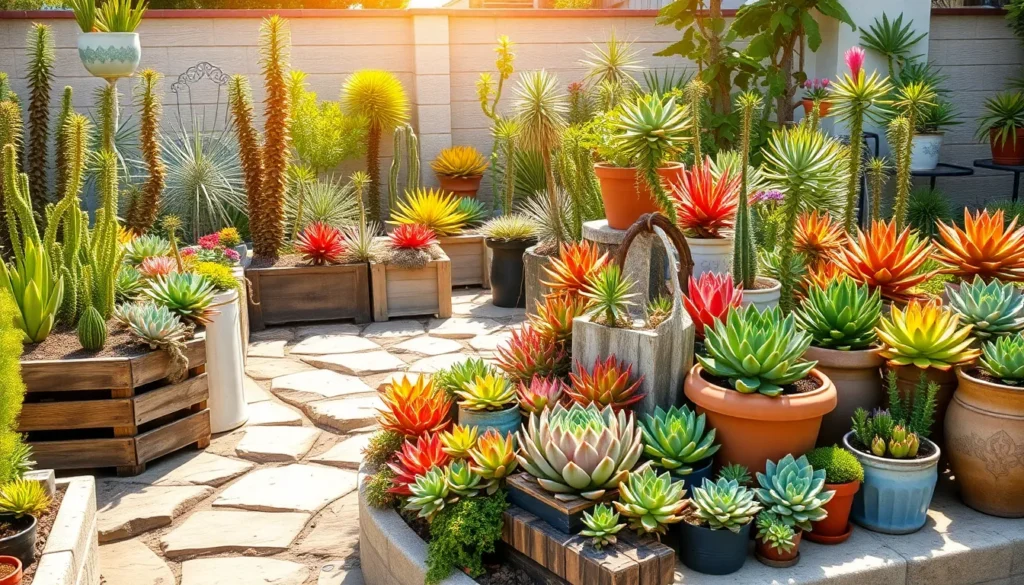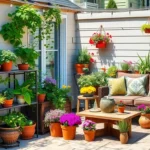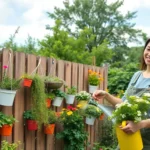We’ve all dreamed of creating that perfect low-maintenance garden that looks stunning year-round without demanding endless hours of care. Succulent gardens offer exactly that – a beautiful outdoor space that thrives with minimal water and attention while delivering maximum visual impact.
These remarkable plants aren’t just drought-tolerant survivors; they’re living sculptures that transform any space into an artistic masterpiece. From towering agaves to delicate jade plants, succulents offer endless possibilities for creative garden design that’ll make your neighbors stop and stare.
Whether you’re working with a sprawling backyard or a tiny balcony, we’ll show you how to create a succulent paradise that fits your space and style. Desert landscaping has never been more accessible, and the best part? You don’t need a green thumb to succeed with these resilient beauties.
Choose the Perfect Location for Your Succulent Garden
Selecting the right spot for your succulent garden determines whether your desert plants will thrive or struggle throughout the seasons. We’ll walk you through the essential location factors that transform ordinary spaces into flourishing succulent havens.
Consider Sunlight Requirements
Most succulents need 6 to 8 hours of direct sunlight daily to maintain their vibrant colors and compact growth patterns. We recommend observing your potential garden spots throughout different times of day to identify areas that receive consistent morning sun exposure.
South-facing locations typically provide the most reliable sunlight for outdoor succulent gardens in most climates. But, some varieties like Haworthia, Gasteria, and certain Echeveria species prefer partial shade or filtered light to prevent leaf burn.
Indoor succulent gardens perform best near south or west-facing windows where natural light streams in consistently. We suggest placing your containers within 3 feet of these bright windows to ensure adequate light penetration.
Full shade areas won’t support most succulent varieties since these plants evolved in desert environments with intense solar exposure. Spots that receive less than 4 hours of direct sunlight often result in stretched, pale plants that lose their characteristic thick, colorful appearance.
Evaluate Drainage Conditions
Proper drainage prevents root rot, the number one killer of succulent plants in garden settings. We always test drainage by digging a 12-inch hole and filling it with water to see how quickly moisture disappears from the soil.
Ideal locations allow water to drain completely within 2 to 4 hours after heavy rainfall or irrigation. Sandy or gravelly soils naturally provide excellent drainage, while clay soils require amendments like perlite, pumice, or coarse sand to improve water flow.
Raised beds offer superior drainage control for succulent gardens, especially in areas with heavy clay soil or poor natural drainage. We recommend building raised beds 6 to 12 inches high using well-draining succulent soil mixtures.
Avoid low-lying areas where water collects after storms, as these spots create consistently moist conditions that damage succulent root systems. Similarly, locations near downspouts or irrigation systems may expose your plants to excessive moisture.
Plan for Seasonal Changes
Winter protection becomes crucial in regions where temperatures drop below 50°F, as most succulents can’t survive freezing conditions. We suggest choosing locations that offer natural windbreaks or easy access for covering plants during cold snaps.
Summer heat considerations matter equally, particularly in desert climates where afternoon temperatures exceed 100°F regularly. Spots with filtered afternoon shade help prevent sun scorch while still providing adequate morning light exposure.
Seasonal sun patterns shift throughout the year, so locations that receive perfect light in summer may become too shaded in winter months. We recommend tracking sun exposure during both growing seasons to ensure year-round success.
Microclimates within your property can provide perfect conditions for different succulent varieties. Areas near south-facing walls typically stay warmer in winter, while spots under deciduous trees offer summer shade protection with winter sun exposure.
Select the Right Succulent Varieties for Your Climate

Now that we’ve established the perfect location for our succulent garden, we need to choose plants that’ll thrive in our exact climate conditions. Matching succulent varieties to our local weather patterns ensures long term success and reduces maintenance requirements.
Research Cold Hardy Options
Agave species top our list for cold tolerant succulents that can withstand freezing temperatures. These architectural plants survive in USDA zones 5-11 depending on the variety, making them excellent choices for northern gardeners. Yucca varieties offer another robust option, with some species like Yucca filamentosa surviving temperatures as low as -20°F.
Sedum species provide incredible cold resistance while offering diverse forms from ground covers to upright varieties. Many sedums remain evergreen through winter months, maintaining garden interest when other plants go dormant. Sempervivum or “hens and chicks” create stunning rosette patterns and survive harsh winter conditions in zones 3-8.
Opuntia cacti surprise many gardeners with their cold tolerance, with some prickly pear varieties surviving in zone 4 climates. These plants often require winter protection from excessive moisture rather than cold temperatures.
Identify Heat Tolerant Species
Aloe varieties excel in hot, sunny conditions and provide year round color with their fleshy, often striped leaves. These plants thrive in temperatures above 70°F and can handle intense summer heat without stress. Echeveria species offer stunning rosette forms in purple, blue, and silver tones while tolerating high temperatures and drought conditions.
Crassula plants including jade varieties maintain their thick, glossy leaves even during extreme heat waves. These succulents actually prefer temperatures between 65-75°F but adapt well to higher ranges. Barrel cacti showcase impressive heat tolerance and create dramatic focal points with their spherical shapes and colorful spines.
Aeonium varieties provide unique tree like forms and can handle both heat and coastal conditions. Many species develop more intense colors during hot, dry periods, adding visual interest to summer gardens.
Mix Different Growth Habits
Combining tall specimens like agave with shorter echeveria creates natural layering that mimics desert landscapes. We position taller plants toward the back or center of planting areas, then surround them with medium height varieties. Repeating similar colors throughout different plant sizes creates visual cohesion while maintaining variety in form.
Incorporating cascading species like string of pearls or burro’s tail adds vertical interest to rock walls or container edges. These trailing varieties soften hard edges and create movement in static garden designs. Grouping plants with contrasting textures such as smooth aloe leaves next to fuzzy kalanchoe creates tactile interest that draws visitors closer.
Clustering odd numbered groups of the same variety prevents formal, symmetrical appearances that conflict with natural desert aesthetics. We arrange plants in groups of three, five, or seven to create more organic looking compositions that feel naturally occurring.
Design Creative Container Gardens
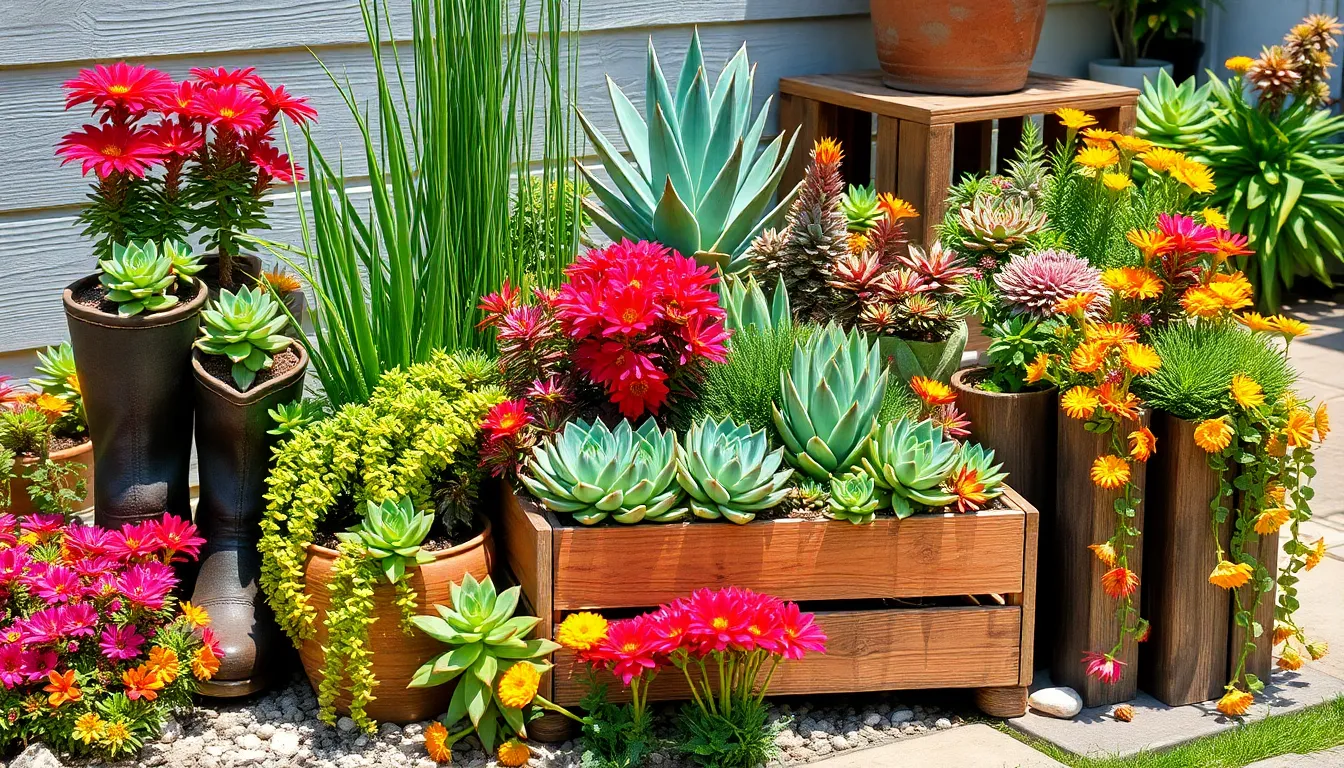
Container gardening offers endless possibilities for showcasing succulent diversity while maintaining complete control over growing conditions. We can transform any space into a stunning desert oasis using creative vessel choices and thoughtful plant combinations.
Use Vintage and Repurposed Planters
Old boots make surprisingly charming succulent containers that add rustic appeal to our garden displays. Vintage wooden crates provide natural drainage and complement the earthy tones of desert plants perfectly. Weathered galvanized buckets create industrial chic containers that showcase colorful kalanchoes and trailing varieties beautifully.
Repurposing everyday items reduces waste while adding unique character to our succulent arrangements. Tea tins work wonderfully for small tabletop displays featuring miniature species. Ceramic colanders naturally provide excellent drainage for larger succulent groupings.
We can drill drainage holes in almost any waterproof container to create custom planters. Mason jars suit tiny air plants and small rosette varieties perfectly for windowsill gardens. Old toolboxes offer compartments for organizing different succulent species by water and light requirements.
Create Vertical Wall Displays
Vertical succulent gardens maximize growing space while creating dramatic living artwork for small areas. Wall mounted planters allow us to display diverse species at eye level for better appreciation of their unique textures and forms. Trellises support cascading varieties that spill downward to create natural waterfall effects.
Living walls thrive with shallow rooted succulents that require minimal soil depth. Pocket planters made from fabric or wood accommodate various sizes while maintaining proper drainage. Modular systems let us rearrange plants seasonally for different color combinations.
We should select drought tolerant varieties that handle vertical growing conditions well. Sedums cascade beautifully while maintaining their compact growth habits. Echeverias form perfect rosettes that create stunning geometric patterns on vertical displays.
Build Multi-Level Arrangements
Sculpting terrain with mounds and valleys enhances drainage while adding visual depth to our container gardens. Raised sections prevent water from pooling around sensitive root systems. Sloped surfaces create natural runoff patterns that mimic desert landscapes.
Multi tiered plantings allow us to showcase different growth habits effectively. Tall specimens like agaves anchor the highest points while shorter varieties fill middle elevations. Ground hugging species spread across lower areas to complete the natural layering effect.
We can use rocks and decorative stones to define elevation changes within larger containers. Pumice amendments improve soil drainage throughout different levels. Gravel mulch helps maintain consistent moisture levels while preventing soil erosion between tiers.
Plan Ground-Level Garden Bed Layouts
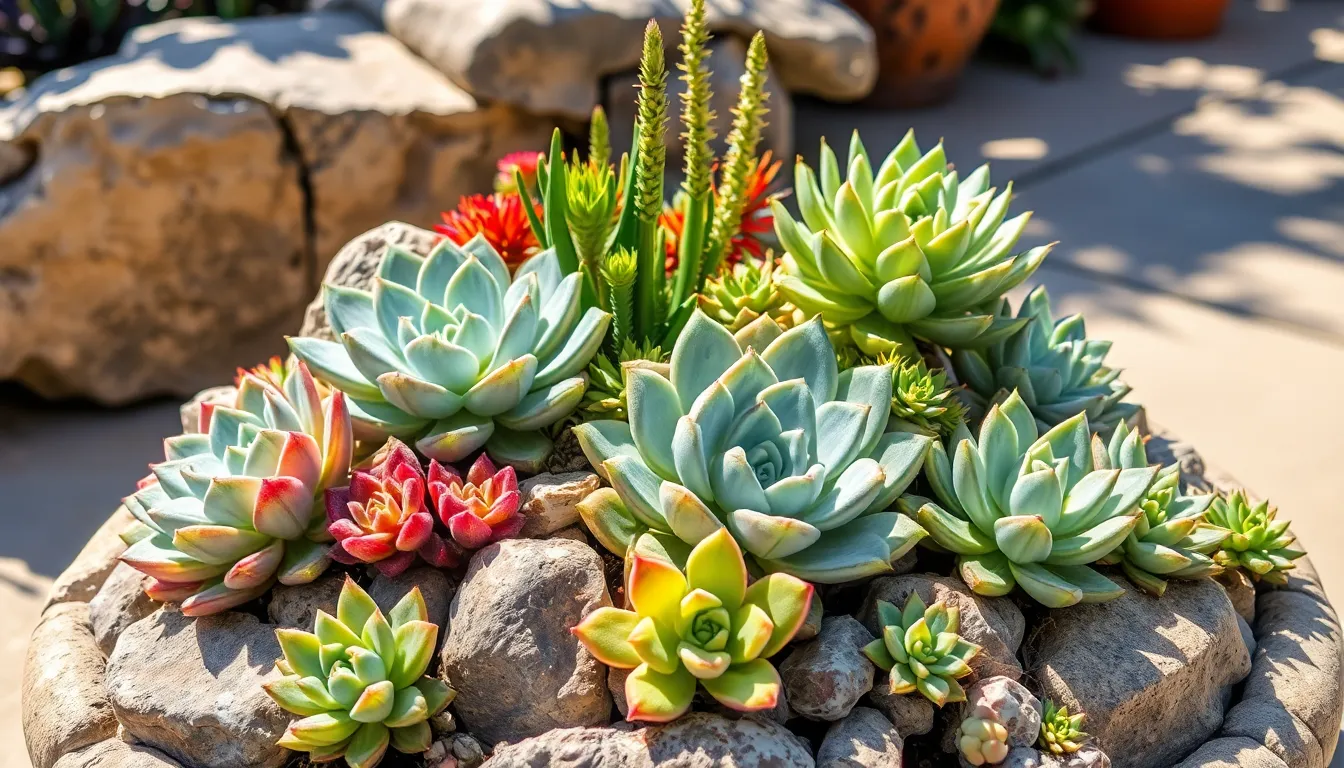
Ground level planting offers the most natural approach to succulent gardening, allowing plants to establish deep root systems while creating expansive displays. We’ll explore strategic layout techniques that maximize visual impact and plant health through thoughtful design principles.
| Layout Element | Key Benefit | Recommended Application |
|---|---|---|
| Mixed Textures | Visual Interest | Combine fuzzy, smooth, and spiky varieties |
| Height Variation | Ever-changing Appearance | Layer tall, medium, and low-growing species |
| Berms and Valleys | Enhanced Drainage | Sculpt terrain for water management |
Design Geometric Patterns
Geometric arrangements transform ordinary succulent beds into striking industry features that catch the eye from every angle. We create visual continuity by repeating similar shapes and colors throughout the design, establishing a cohesive theme that ties the entire garden together. Contrasting patterns between different succulent varieties add dramatic flair while maintaining the overall geometric structure.
Triangular formations work particularly well with rosette shaped succulents like echeveria and sempervivum, creating natural focal points that draw attention. Circular patterns using agave or barrel cacti as centerpieces establish strong geometric anchors around which smaller varieties can radiate outward. Linear arrangements along pathways or borders create clean, modern lines that complement contemporary industry designs.
We achieve the most striking results by alternating contrasting colors in geometric sequences, such as silver blue agaves paired with deep purple aeoniums. This technique creates rhythm and movement within the static geometric framework, making the garden feel both structured and ever-changing.
Create Natural Rock Garden Settings
Natural rock elements provide the perfect backdrop for succulent displays while solving practical drainage challenges that these plants require. We integrate rocks, pebbles, and boulders strategically throughout the garden to mimic the natural desert environments where most succulents originate. These stone features create microclimates that help regulate soil temperature and moisture levels.
Boulder placement serves multiple purposes beyond aesthetics, creating natural windbreaks and providing afternoon shade for more sensitive varieties. Gravel mulch around plant bases prevents water from sitting against stems and crowns, reducing the risk of rot while maintaining the natural desert appearance. River rocks and decomposed granite work exceptionally well as pathways through succulent beds, allowing easy maintenance access without disturbing plant roots.
We position larger stones to create natural terracing effects that improve drainage on sloped sites while adding vertical interest to flat landscapes. This approach mimics natural rock outcroppings and provides perfect growing conditions for trailing varieties like string of pearls or burro’s tail.
Establish Color-Coordinated Groupings
Color coordination creates the most visually impactful succulent gardens by establishing harmonious relationships between different plant varieties. We group plants with similar color tones together to create soothing, monochromatic sections that feel cohesive and intentional. Cool toned varieties like blue agaves, silver echeverias, and purple aeoniums work beautifully together in shaded areas.
Warm color groupings featuring red kalanchoes, orange sedums, and yellow barrel cacti create vibrant focal areas that energize the industry. We use these bright clusters sparingly as accent points rather than overwhelming the entire garden with intense colors. Green varieties in different shades and textures serve as neutral connectors between more colorful groupings.
Contrasting color combinations require careful balance to avoid creating chaotic or jarring effects in the garden design. We achieve successful contrast by using the 60-30-10 rule, where one color dominates the space, a secondary color provides support, and an accent color adds punch through varieties like bright pink bougainvillea or orange marigolds planted sparingly throughout the design.
Incorporate Decorative Elements and Hardscaping
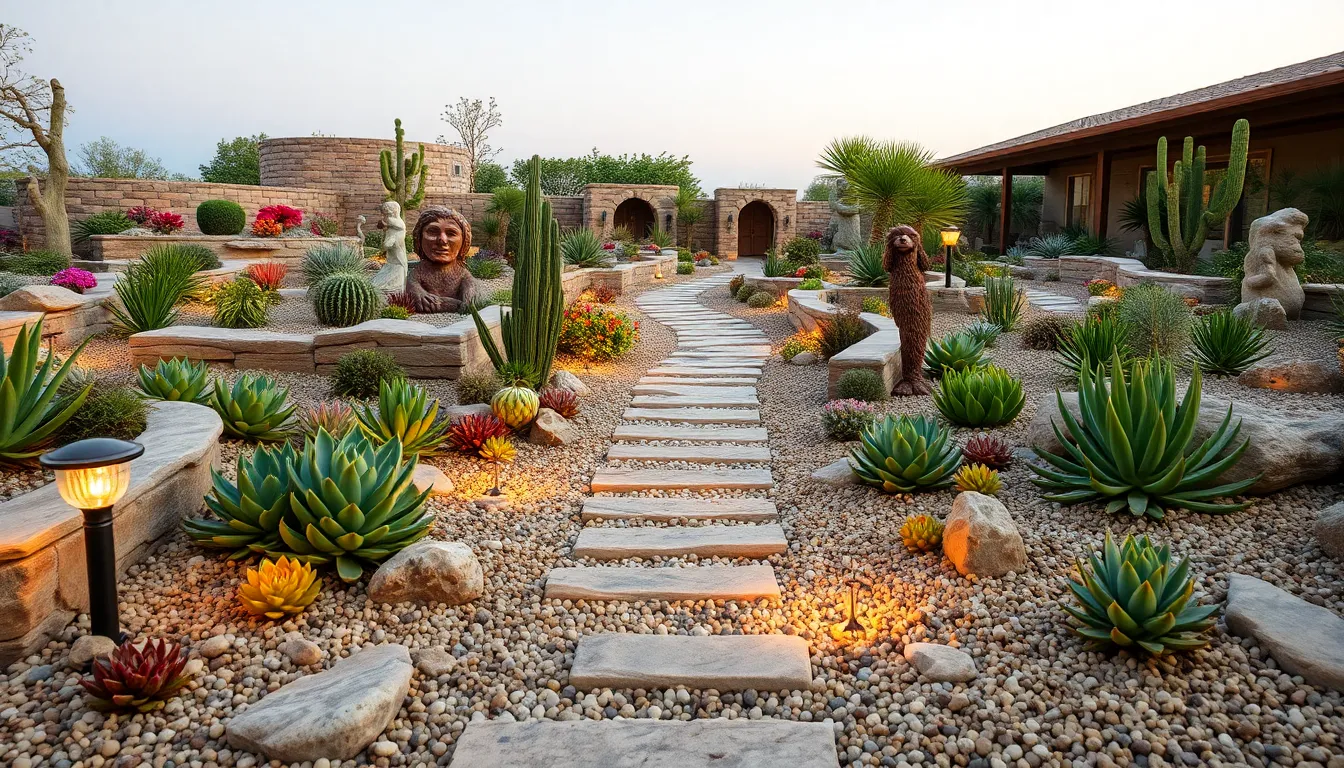
Transform our succulent garden beyond plant selection by adding structural elements that enhance both functionality and visual appeal. These hardscaping features create lasting beauty while providing practical benefits for our desert industry design.
Add Natural Stone and Gravel Pathways
Stone pathways offer durability and natural beauty that perfectly complement succulent gardens. We recommend limestone, granite, or bluestone for their weather resistance and timeless aesthetic appeal. These materials create striking contrasts against the soft textures of our succulent plantings while providing stable walking surfaces.
Gravel serves as an excellent pathway material that promotes proper drainage around our plants. Pea gravel and decomposed granite work exceptionally well because they’re comfortable to walk on and allow water to filter through naturally. We can use these materials to connect different garden areas while maintaining the desert theme throughout our industry.
Different stone sizes create visual interest and define exact garden zones. Large flagstones work beautifully for main walkways, while smaller pebbles can outline individual planting beds. This layered approach adds depth and guides visitors through our carefully planned succulent displays.
Install Sculptural Garden Features
Mounding and berms add essential height variations while improving drainage conditions for our succulents. We can create these elevated areas using native soil mixed with sand and gravel, which naturally channels water away from plant roots. These sculptural landforms also provide opportunities to showcase specimen plants at eye level.
Water features bring unexpected elements to our drought-tolerant gardens without overwhelming the desert aesthetic. Small fountains or birdbaths add gentle sounds and visual focal points while attracting beneficial wildlife. We should choose designs that complement our stone pathways and maintain the overall garden theme.
Garden sculptures and ornamental pieces serve as year-round focal points that maintain interest during dormant seasons. Metal agave sculptures or stone cairns work particularly well because they echo the natural forms of our living plants. We can position these elements to create sightlines and draw attention to our most impressive succulent groupings.
Include Complementary Lighting Options
Solar-powered lights offer eco-friendly illumination that highlights our succulent features without requiring electrical installation. We can place these fixtures along pathways or near specimen plants to create dramatic evening displays. Solar options work particularly well because they charge during sunny days when our succulents are also thriving.
String lights create magical ambiance for evening garden enjoyment while outlining architectural features. We can drape them along pergolas, wrap them around large cacti, or hang them between posts to define outdoor seating areas. LED versions provide long-lasting, energy-efficient lighting that won’t generate excessive heat near our plants.
Uplighting transforms our sculptural succulents into nighttime artwork by casting dramatic shadows and highlighting interesting plant forms. We should focus these lights on our tallest specimens like century plants or barrel cacti to create striking silhouettes. This technique extends our garden’s visual impact well beyond daylight hours.
Combine Succulents with Other Drought-Tolerant Plants
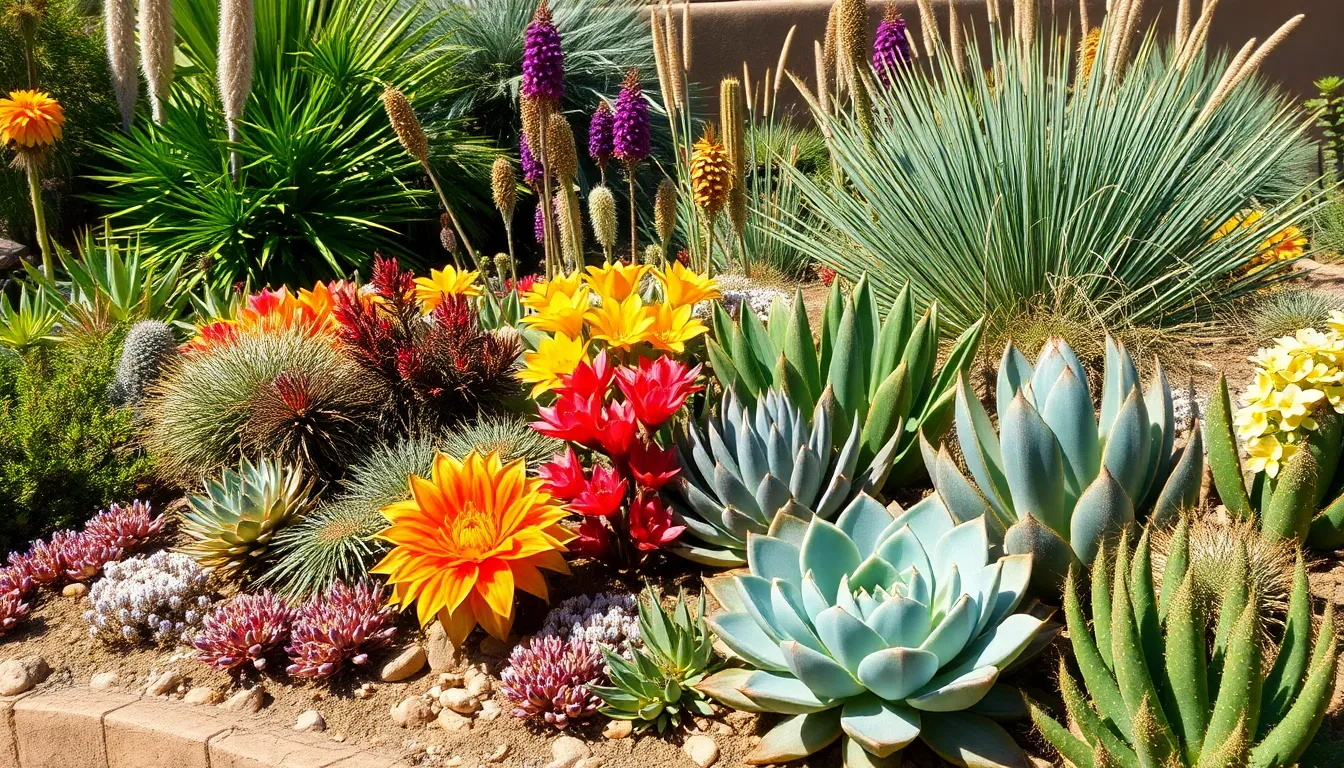
Expanding your succulent collection with complementary drought-tolerant plants creates depth and visual interest while maintaining the low-maintenance appeal. We’ll explore strategic plant partnerships that enhance your garden’s texture and ecological value.
Pair with Native Grasses
Native grasses bring movement and softness that perfectly balances the structured forms of succulents. These grasses help maintain soil health while providing natural habitat for local wildlife, creating an network that supports both plants and animals.
Ornamental varieties like buffalo grass and blue grama grass offer seasonal color changes that complement succulent displays throughout the year. We recommend positioning taller grass species behind lower-growing succulents to create layered compositions that draw the eye upward.
Bunch grasses work particularly well as accent plants between succulent clusters, their flowing textures creating natural transitions between different garden zones. Native species require minimal irrigation once established, making them ideal companions for water-wise gardening approaches.
Integrate Mediterranean Herbs
Mediterranean herbs like rosemary and thyme thrive in the same dry conditions that succulents prefer. These aromatic plants add culinary value to your garden while attracting beneficial pollinators that support the broader network.
Lavender creates stunning purple spikes that contrast beautifully with the geometric forms of agaves and aloes. We suggest planting herbs along garden edges where their fragrance can be enjoyed during maintenance activities.
Oregano and sage provide year-round foliage that maintains garden interest even when succulents enter dormancy periods. These herbs also offer natural pest deterrent properties that protect nearby succulent plantings from common garden pests.
Add Ornamental Cacti Varieties
Ornamental cacti like barrel cacti and yuccas add dramatic height variation and sculptural appeal to succulent gardens. Varieties such as ‘Sticks on Fire’ provide vibrant seasonal colors that create focal points throughout your industry design.
Yucca rostrata offers striking architectural forms that serve as natural garden sculptures while requiring minimal care. We recommend creating visual balance by pairing tall cacti specimens with lower-growing succulent groundcovers.
Textural plants like fuzzy kangaroo paw flowers can be incorporated alongside cacti to provide visual interest and soften harsh desert aesthetics. Using berms and mounds enhances drainage for both succulents and cacti while creating visually interesting terrain that mimics natural desert landscapes.
Create Themed Succulent Garden Concepts
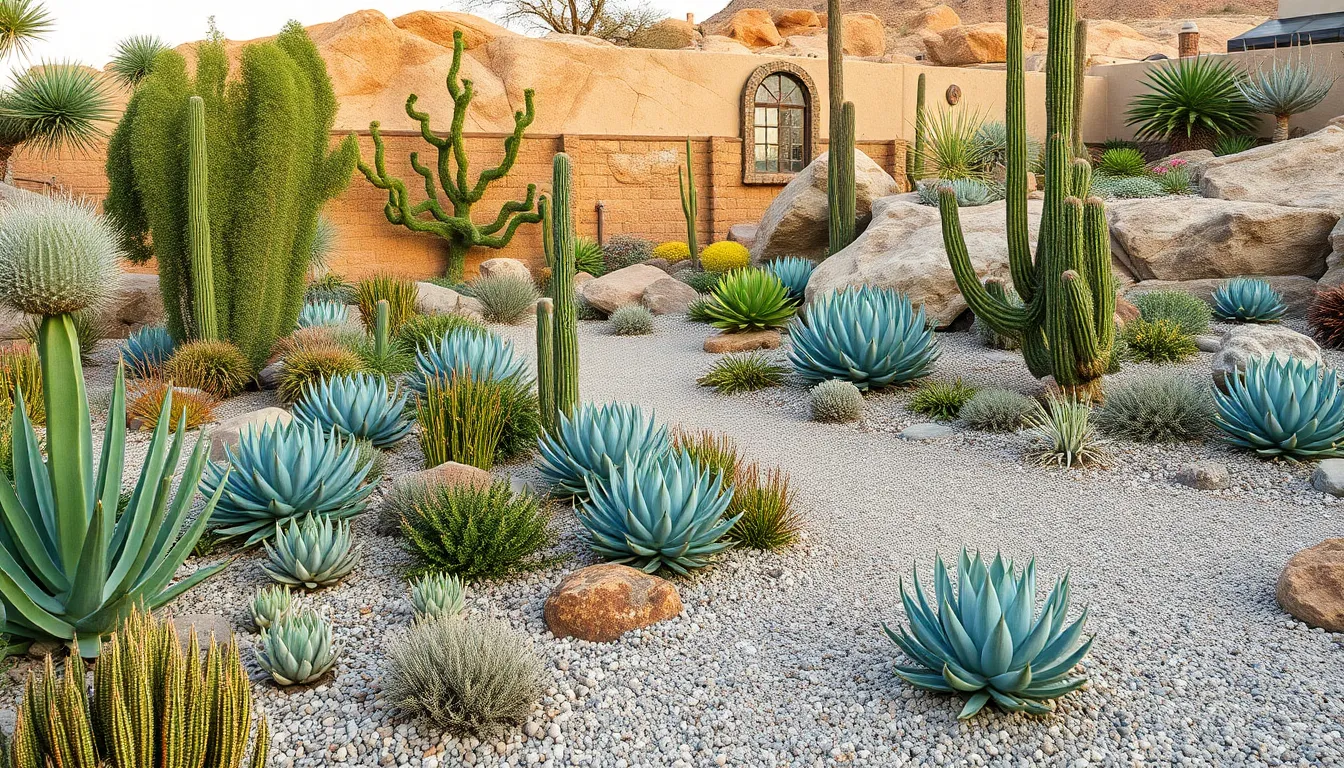
Themed succulent gardens transform ordinary plantings into captivating outdoor narratives. We’ll explore three distinct design approaches that showcase succulent versatility while creating memorable garden experiences.
Build a Desert Industry
Desert landscapes showcase nature’s raw beauty through dramatic plants and sculptural terrain. We sculpt our garden with berms and valleys to mimic natural desert formations, creating visual depth and improved drainage throughout the space.
Yucca and agave plants anchor our desert theme with their sword-like leaves and architectural presence. These dramatic specimens create living fortifications that capture the essence of southwestern landscapes. Positioning them at varying heights emphasizes their sculptural qualities while establishing clear focal points.
Rock features complete our desert transformation through strategic placement of large boulders and gravel pathways. Weathered sandstone and decomposed granite add authentic texture while solving practical drainage needs. Layering different stone sizes creates natural looking outcroppings that frame our succulent collections.
Design a Coastal-Inspired Garden
Coastal gardens evoke seaside tranquility through ocean-inspired colors and beachside elements. We select blue-tinged succulents like Senecio serpens to mirror ocean waves and create cooling visual effects throughout our planting scheme.
Sea-inspired decorations enhance our coastal narrative without overwhelming the natural beauty. Weathered driftwood pieces serve as sculptural accents while providing climbing support for trailing varieties. Smooth river rocks and shells scattered strategically reinforce our seaside theme.
Sandy soil mixtures complete our beach environment while providing excellent drainage. Coarse sand blended with pumice creates the perfect growing medium that mimics natural coastal conditions. This specialized soil keeps roots healthy while maintaining our authentic seaside aesthetic.
Establish a Modern Minimalist Space
Modern minimalist gardens emphasize clean design through purposeful plant selection and uncluttered arrangements. We choose succulents in monochromatic color schemes to create cohesive visual flow that feels both contemporary and serene.
Simple planters anchor our minimalist approach through geometric shapes and neutral colors. Concrete containers and sleek metal vessels provide striking contrast against soft succulent textures. Square and rectangular forms reinforce our modern aesthetic while offering practical growing space.
Clean lines define our garden’s architectural character through strategic spacing and geometric patterns. Removing visual clutter allows each succulent’s natural form to shine as living sculpture. Precise placement creates rhythm and balance that feels both sophisticated and effortlessly elegant.
Plan for Proper Soil Preparation and Drainage
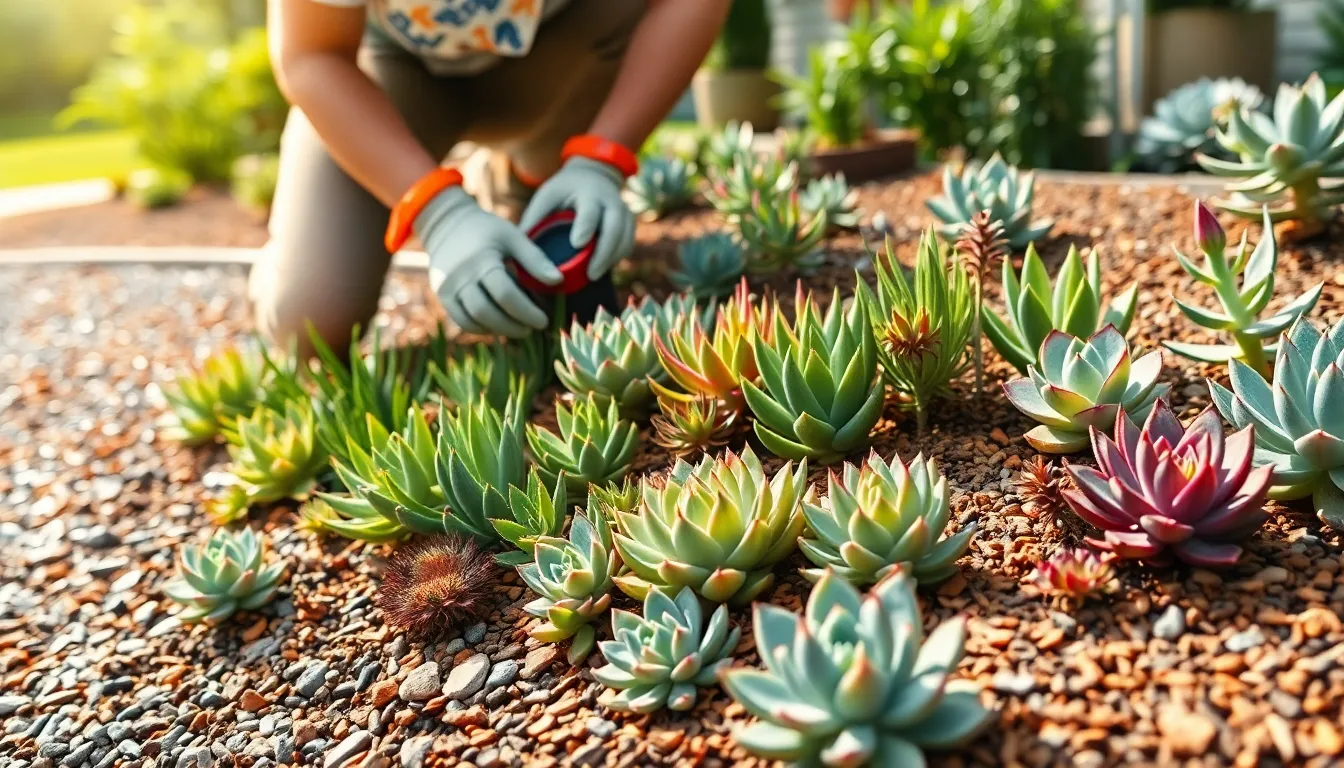
Successful succulent gardens depend entirely on soil conditions that prevent water from sitting around plant roots. We’ll guide you through three essential steps to create the perfect growing environment for your drought loving plants.
Mix Custom Soil Blends
Creating the perfect soil mixture starts with understanding that succulents require well draining soil to prevent root rot. We recommend mixing standard potting soil with amendments like pumice to enhance drainage capabilities significantly. Pumice provides excellent aeration while maintaining lightweight properties that roots can easily penetrate.
Sand additions help improve drainage but avoid fine sand that can compact over time. We suggest using coarse sand or perlite as alternatives that maintain soil structure. The ideal blend contains approximately 50% standard soil and 50% drainage amendments for optimal plant health.
Commercial cactus soil mixes offer convenient alternatives but often need additional amendments for outdoor gardens. We enhance these products by adding extra pumice or coarse materials to achieve better drainage rates.
Install Drainage Systems
Proper drainage systems ensure that excess water moves away from succulent roots quickly after watering or rain events. We create drainage answers by installing gravel layers beneath planting areas or constructing raised beds that promote water movement.
French drains work exceptionally well in areas with clay soil or poor natural drainage conditions. We dig trenches filled with gravel and perforated pipes to redirect water away from planting zones. These systems prevent waterlogged conditions that kill succulents within days.
Raised bed construction provides another effective drainage solution while improving soil warming in cooler climates. We build beds 6 to 12 inches high using stones, timber, or concrete blocks to elevate plants above problem drainage areas.
Add Mulching Materials
Mulching serves multiple purposes in succulent gardens by retaining appropriate moisture levels while suppressing weed growth. We apply organic mulches like bark chips or inorganic options such as decorative gravel around established plants.
Gravel mulches complement desert themed gardens while providing excellent drainage and temperature regulation benefits. We use different colored stones to create visual interest while maintaining practical growing conditions. River rock, decomposed granite, and lava rock all work effectively.
Organic mulches break down over time and can retain too much moisture for some succulent varieties. We monitor these materials carefully and replace them when they become overly decomposed or water retentive.
Develop a Low-Maintenance Care Routine
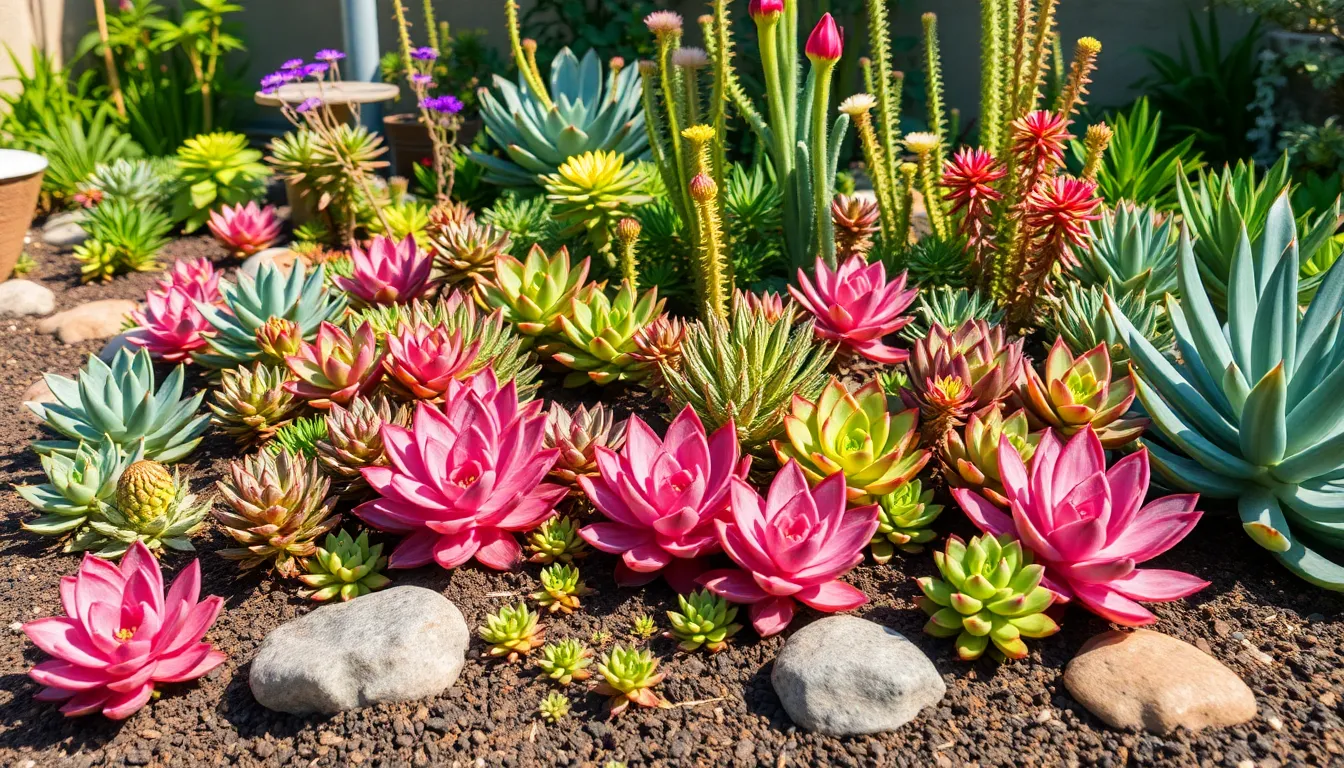
Creating a sustainable care routine ensures our succulent garden thrives without constant attention. We can establish simple practices that work with our plants’ natural drought tolerance.
Establish Watering Schedules
Deep watering sessions followed by complete soil drying create the ideal moisture cycle for succulents. We should water thoroughly at the base of each plant, allowing excess water to drain completely before the next session. Seasonal adjustments help us match our watering frequency to environmental conditions—increasing water during hot, dry months while reducing frequency in winter when plants enter dormancy.
Overhead watering causes leaf rot and disease problems in succulent gardens. We can prevent these issues by directing water specifically to the soil around plant bases rather than spraying leaves. Weekly deep watering during growing season typically provides sufficient moisture, though we’ll adjust based on rainfall and temperature changes in our exact location.
Plan Seasonal Maintenance Tasks
Spring maintenance begins with removing dead leaves and pruning overgrown stems to encourage healthy new growth. We should inspect each plant for pest damage and disease symptoms at the start of each growing season when problems are easiest to address. Annual soil condition checks help us identify compaction issues before they affect plant health.
Light fertilization using low nitrogen fertilizer supports spring growth without encouraging excessive leaf production. We can replenish mulch layers annually to maintain weed suppression and moisture retention benefits. Regular deadheading of spent flowers redirects plant energy toward root development and overall health.
Monitor for Common Issues
Mealybugs and spider mites represent the most frequent pest threats in succulent gardens. We should examine plants monthly for white cottony masses or fine webbing that indicate infestations requiring treatment with insecticidal soap. Early detection allows us to remove affected plants or treat problems before they spread throughout our garden.
Overwatering symptoms include soft, discolored leaves that feel mushy when touched. We can prevent root rot by ensuring our soil drains completely between watering sessions and checking for standing water after heavy rains. Frost protection becomes necessary when temperatures drop below our plants’ tolerance levels—covering sensitive varieties or moving containers indoors during extreme cold events protects our investment.
Conclusion
We’ve covered everything you need to transform your outdoor space into a stunning succulent paradise. From selecting the perfect drought-tolerant varieties to creating eye-catching displays with containers and ground beds these plants offer endless possibilities for creative expression.
The beauty of succulent gardening lies in its simplicity and forgiveness. With proper soil preparation good drainage and minimal maintenance you’ll enjoy a thriving garden that looks spectacular year-round. Whether you’re working with a small balcony or expansive yard these resilient plants adapt to your space and lifestyle.
Your succulent garden will reward you with vibrant colors unique textures and architectural beauty while requiring less water and care than traditional gardens. Start small experiment with different arrangements and watch as your desert-inspired oasis becomes a focal point that brings joy for years to come.
Frequently Asked Questions
What makes succulents ideal for low-maintenance gardens?
Succulents are drought-tolerant plants that store water in their leaves, stems, or roots, making them extremely resilient to dry conditions. They require minimal watering, thrive in poor soils, and can survive neglect better than most plants. Their architectural forms also provide year-round visual interest, making them perfect for busy gardeners who want beauty without constant maintenance.
How much sunlight do succulents need to thrive?
Most succulents require 6-8 hours of direct sunlight daily to maintain their compact shape and vibrant colors. However, some varieties can tolerate partial shade. In extremely hot climates, afternoon shade can prevent leaf burn. Proper sunlight exposure is crucial for preventing stretching and maintaining the plants’ characteristic appearance.
What type of soil is best for succulent gardens?
Succulents need well-draining soil that prevents water from sitting around their roots. Mix standard potting soil with amendments like pumice, coarse sand, or perlite to create a fast-draining blend. The soil should dry completely between waterings. Heavy clay soils should be amended extensively or replaced entirely for succulent success.
Can I grow succulents in containers year-round?
Yes, container gardening offers excellent control over growing conditions and allows you to move plants for protection during extreme weather. Use pots with drainage holes and well-draining soil. Container gardens are perfect for patios, balconies, and areas with poor soil. Just ensure adequate drainage and proper sizing as plants grow.
How often should I water my succulent garden?
Water deeply but infrequently, allowing soil to dry completely between waterings. During growing season (spring/summer), water every 7-14 days depending on climate. In winter, reduce watering to monthly or less. Always check soil moisture first – when in doubt, wait longer. Overwatering is more harmful than underwatering for succulents.
What are the best cold-hardy succulents for northern climates?
Hardy succulents like Sempervivum (hens and chicks), Sedum varieties, and some Agave species can survive freezing temperatures. These plants often change colors in cold weather, adding winter interest. Plant them in well-draining soil and provide protection from wet winter conditions, which cause more damage than cold temperatures alone.
How do I create visual interest in my succulent garden design?
Mix different textures, heights, and growth habits for dynamic displays. Combine tall specimens with low-growing varieties and add cascading species for movement. Use color-coordinated groupings and geometric patterns. Incorporate natural stones, create different levels with berms, and add pathways to guide the eye through your garden composition.
What companion plants work well with succulents?
Drought-tolerant plants like native grasses, Mediterranean herbs (rosemary, thyme), and ornamental cacti complement succulents perfectly. These plants share similar water and soil requirements while adding different textures and heights. Native grasses provide movement, herbs offer culinary benefits, and cacti add dramatic sculptural elements to enhance overall garden appeal.
How do I prevent common succulent problems like root rot?
Ensure proper drainage through well-draining soil, drainage holes in containers, and gravel layers in garden beds. Water at soil level rather than overhead to prevent leaf rot. Avoid overwatering by checking soil moisture before watering. Remove dead or damaged plant material promptly and provide adequate air circulation between plants.
Can I add decorative elements to enhance my succulent garden?
Absolutely! Natural stone pathways, gravel mulch, and rock features complement desert aesthetics while improving drainage. Add sculptural elements, small water features, and garden art as focal points. Solar lighting can highlight plants at night. Choose decorative elements that enhance rather than compete with your succulents’ natural beauty.
